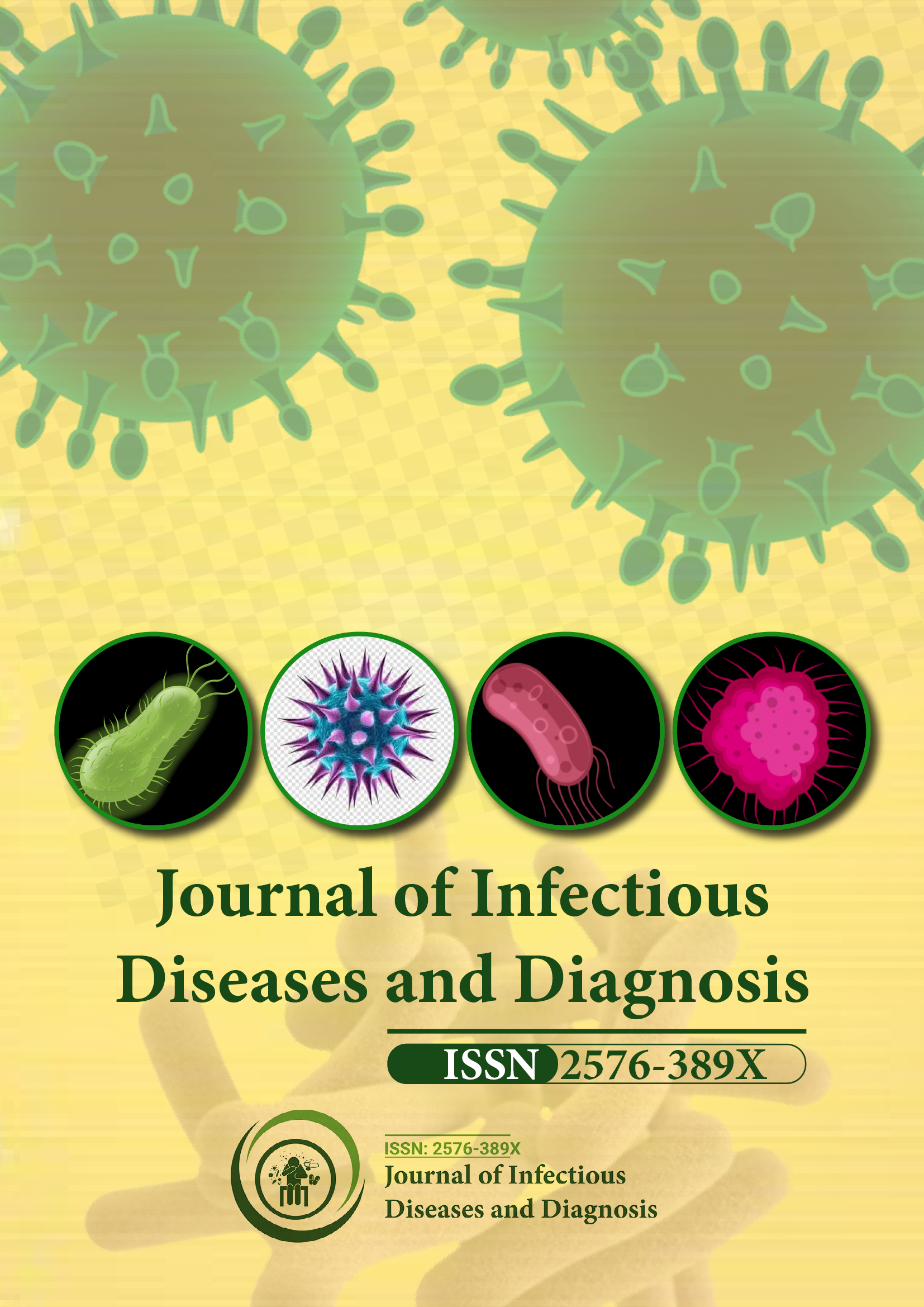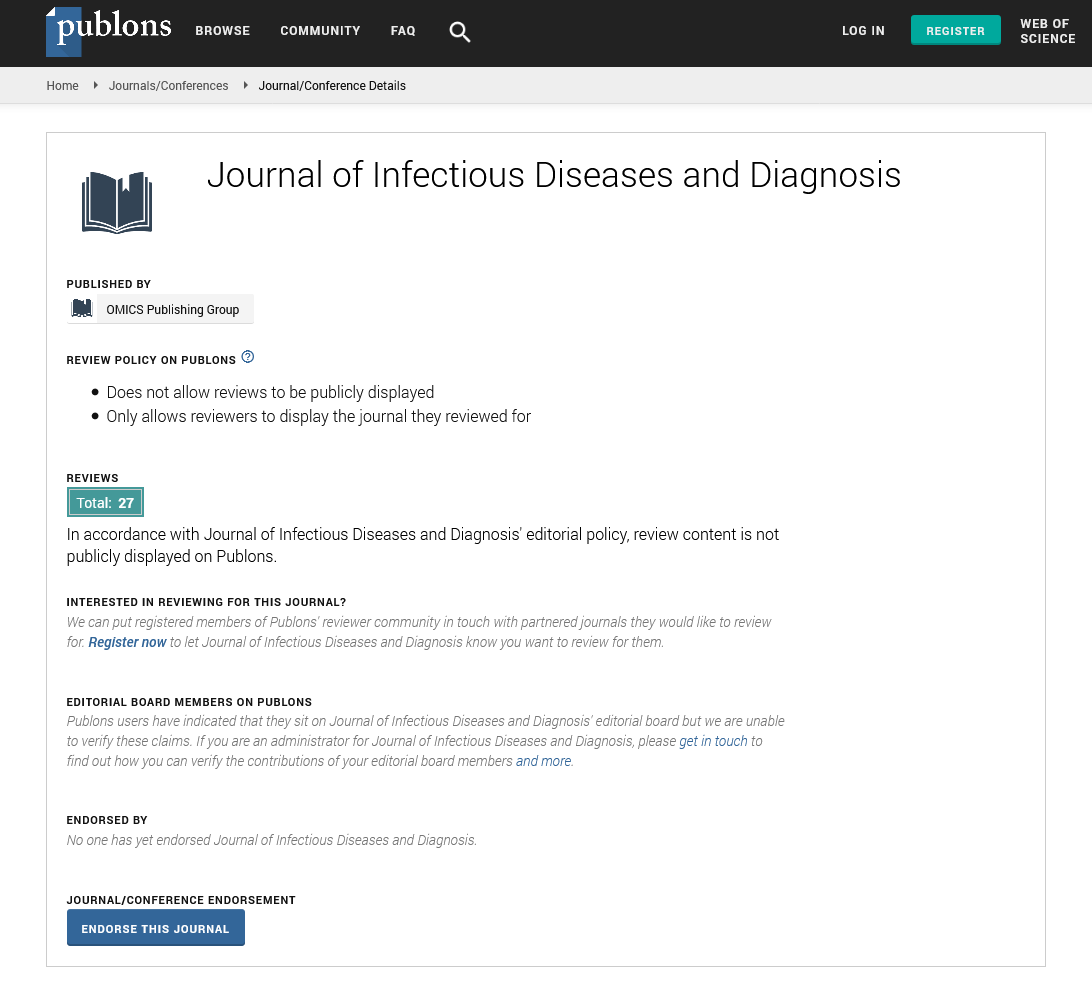Indexed In
- RefSeek
- Hamdard University
- EBSCO A-Z
- Publons
- Euro Pub
- Google Scholar
Useful Links
Share This Page
Journal Flyer

Open Access Journals
- Agri and Aquaculture
- Biochemistry
- Bioinformatics & Systems Biology
- Business & Management
- Chemistry
- Clinical Sciences
- Engineering
- Food & Nutrition
- General Science
- Genetics & Molecular Biology
- Immunology & Microbiology
- Medical Sciences
- Neuroscience & Psychology
- Nursing & Health Care
- Pharmaceutical Sciences
Opinion Article - (2025) Volume 10, Issue 1
Tropical Infectious Diseases: Challenges and Management Strategies
Xu Chen*Received: 01-Jan-2025, Manuscript No. JIDD-25-28527; Editor assigned: 03-Jan-2025, Pre QC No. JIDD-25-28527 (PQ); Reviewed: 17-Jan-2025, QC No. JIDD-25-28527; Revised: 24-Jan-2025, Manuscript No. JIDD-25-28527 (R); Published: 31-Jan-2025, DOI: 10.35248/2576-389X.25.10.315
Description
Tropical infectious diseases remain a major public health concern, particularly in regions with warm climates and high humidity. These diseases, including malaria, dengue, chikungunya and leishmaniasis, continue to affect millions of people annually, contributing to high morbidity and mortality rates. The transmission of these infections is influenced by environmental conditions, socioeconomic factors and human activities. Vector-borne infections such as malaria and dengue fever continue to challenge public health systems, while Neglected Tropical Diseases (NTDs) like schistosomiasis and lymphatic filariasis affect marginalized populations. Addressing these infections requires a multifaceted approach that includes early detection, treatment and prevention. Common tropical infectious diseases are:
Malaria
Malaria is a mosquito-borne disease caused by Plasmodium parasites, primarily transmitted through the bites of infected Anopheles mosquitoes. Symptoms include fever, chills and muscle pain, with severe cases leading to organ failure and death. Malaria control measures include insecticide-treated bed nets, indoor residual spraying and antimalarial medications such as artemisinin-based combination therapies (ACTs). Although significant progress has been made in reducing malaria cases globally, drug resistance and climate change pose ongoing challenges.
Dengue fever
Dengue fever is a viral illness transmitted by Aedes mosquitoes, primarily Aedes aegypti. The disease manifests with high fever, severe headache, joint pain and skin rashes. In some cases, dengue progresses to severe forms such as dengue hemorrhagic fever or dengue shock syndrome, which can be fatal. Preventive measures include mosquito control programs, public awareness campaigns and the introduction of vaccines like Dengvaxia. However, controlling Aedes mosquito populations remains a difficult task due to their ability to breed in urban environments.
Chikungunya
Chikungunya is another mosquito-borne viral disease that causes fever, rash and prolonged joint pain, which can persist for months. Aedes mosquitoes, the same vectors responsible for dengue, also transmit chikungunya. Since there is no specific antiviral treatment, management focuses on symptom relief through painkillers and supportive care. Efforts to control chikungunya outbreaks rely on reducing mosquito breeding sites and promoting community participation in vector control activities.
Leishmaniasis
Leishmaniasis is caused by Leishmania parasites, which are transmitted by infected sandflies. It presents in different forms, including cutaneous leishmaniasis, which causes skin sores and visceral leishmaniasis, a more severe form affecting internal organs. Treatment options include antimonial drugs, amphotericin B and miltefosine. Vector control measures and improved diagnostic tools are essential for managing this disease, particularly in remote areas with limited medical resources.
Schistosomiasis
Schistosomiasis is a parasitic disease caused by Schistosoma worms, which infect humans through contact with contaminated freshwater. The disease can lead to liver damage, kidney failure and bladder cancer if left untreated. Mass drug administration (MDA) using praziquantel has been effective in reducing schistosomiasis prevalence in endemic regions. However, improving sanitation and access to clean water remains a key strategy for long-term control.
Lymphatic filariasis
Lymphatic filariasis, also known as elephantiasis, is a parasitic disease caused by filarial worms transmitted by mosquitoes. It leads to severe swelling of the limbs and genitalia, causing disability and social stigma. Large-scale deworming programs with drugs such as ivermectin and albendazole have significantly reduced infection rates. However, continued efforts are needed to eliminate the disease in affected communities.
Factors contributing to the spread of tropical infectious diseases
Several factors influence the transmission and persistence of tropical infectious diseases:
Climate and environmental changes: Rising temperatures, increased rainfall and deforestation create favorable conditions for vectors and pathogens to thrive.
Urbanization and population growth: Expanding urban areas often lack proper sanitation and waste management, increasing breeding grounds for disease-carrying insects.
Limited healthcare access: Many tropical regions suffer from inadequate healthcare infrastructure, making it difficult to diagnose and treat diseases promptly.
Travel and migration: Global travel facilitates the spread of tropical infections to new regions, making disease control a worldwide concern.
Prevention and control strategies
To address the burden of tropical infectious diseases, a combination of preventive measures and treatment strategies is necessary.
Vector control: Controlling mosquito and sandfly populations through insecticide spraying, bed nets and larval source reduction can limit disease transmission.
Vaccination programs: Vaccines, where available, provide longterm protection against diseases like yellow fever and dengue. Research into new vaccines for malaria and leishmaniasis continues to advance.
Improved sanitation: Providing access to clean water and proper waste disposal reduces exposure to waterborne and parasitic infections.
Community engagement: Educating communities about disease prevention, symptom recognition and the importance of seeking medical care can help reduce infection rates.
Surveillance and early detection: Strengthening disease monitoring systems allows for rapid outbreak response and timely medical interventions.
Conclusion
Tropical infectious diseases remain a significant health challenge, particularly in low-income countries where healthcare infrastructure is limited. Addressing these diseases requires an integrated approach that includes vector control, vaccination, improved sanitation and community-based initiatives. Although progress has been made in managing some of these infections, ongoing research, policy implementation and global collaboration are necessary to reduce their impact on public health.
Citation: Chen X (2025). Tropical Infectious Diseases: Challenges and Management Strategies. J Infect Dis Diagn. 10:315.
Copyright: © 2025 Chen X. This is an open-access article distributed under the terms of the Creative Commons Attribution License, which permits unrestricted use, distribution and reproduction in any medium, provided the original author and source are credited.

